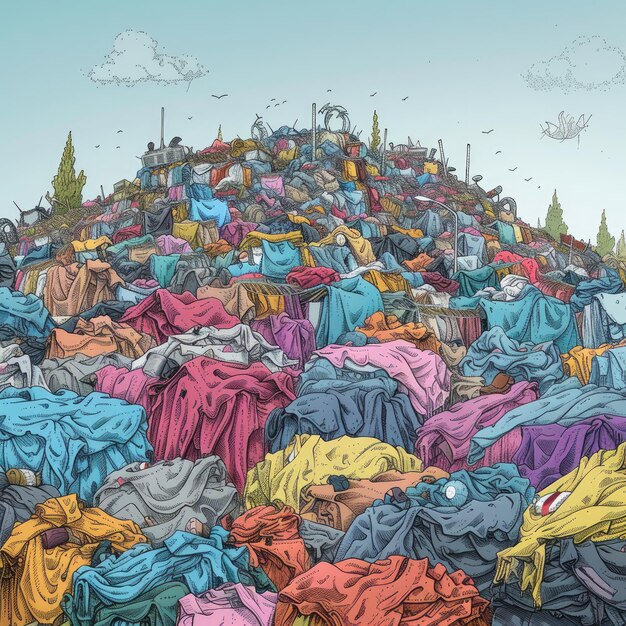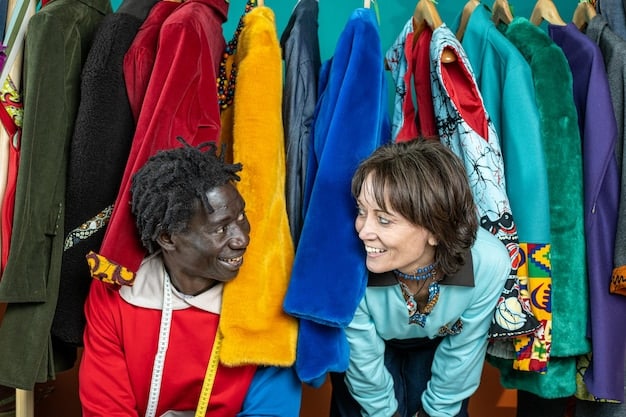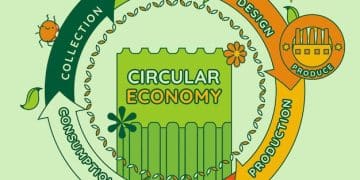Environmental Impacts of Fast Fashion & Sustainable Shopping Guide

The fast fashion industry drastically impacts the environment with extensive resource consumption, pollution, and waste generation, making conscious consumer choices and sustainable shopping practices crucial for mitigating its pervasive ecological footprint.
Exploring what are the environmental impacts of fast fashion and how to shop sustainably is more crucial than ever in an era where clothing consumption continually accelerates. This deep dive will unravel the complex environmental footprint left by rapid clothing production and offer actionable insights into more eco-conscious purchasing decisions, transforming how we interact with our wardrobes.
The Hidden Ecological Footprint of Fast Fashion
The fast fashion industry, characterized by rapid production cycles, trend replication, and low prices, exerts an enormous and often hidden toll on our planet. From the raw materials used to the disposal of garments, every stage of the clothing lifecycle is fraught with environmental challenges. Understanding these impacts is the first step toward embracing more sustainable practices.
Resource Depletion and Pollution
The insatiable demand for new clothing fuels an unprecedented exploitation of natural resources. Textile production, particularly cotton, requires immense quantities of water, often in drought-prone regions. Synthetic fibers, such as polyester and nylon, are derived from fossil fuels, contributing to carbon emissions and our reliance on non-renewable sources.
- Water Consumption: Growing cotton for a single t-shirt can consume up to 2,700 liters of water, enough drinking water for one person for 2.5 years.
- Pesticide Use: Conventional cotton farming heavily relies on pesticides and insecticides, contaminating soil and water sources, and posing risks to agricultural workers and local ecosystems.
- Energy Intensity: The production of synthetic fibers is energy-intensive, primarily relying on coal and natural gas, exacerbating greenhouse gas emissions.
Beyond raw material acquisition, the dyeing and finishing processes involved in manufacturing are significant contributors to water pollution. Dyes, chemicals, and heavy metals are often discharged into rivers and waterways, particularly in developing countries with lax environmental regulations. This wastewater pollutes ecosystems, harms aquatic life, and can make water unsafe for human consumption. The aesthetic appeal of cheap, vibrant clothing comes at a steep environmental cost, one that disproportionately affects vulnerable communities.
Microplastic Contamination from Synthetic Fabrics
With the prevalence of synthetic materials in fast fashion, another insidious problem has emerged: microplastic pollution. Every time synthetic garments are washed, tiny plastic fibers are shed and enter our wastewater systems. These microfibers are too small to be filtered out by most treatment plants, subsequently making their way into rivers, lakes, and oceans.
Once in aquatic environments, microplastics are ingested by marine life, entering the food chain and potentially ending up on our plates. Scientists are still studying the long-term health implications for both ecosystems and humans, but the evidence points to a growing environmental crisis. The ubiquity of affordable fleece and activewear, for example, directly contributes to this global challenge. This highlights that “environmental impact” extends far beyond visible pollution, reaching into the microscopic.
The Global Waste Epidemic Caused by Fast Fashion
The fast fashion model thrives on disposability. Clothes are designed to be cheap, trendy, and often not built to last, encouraging consumers to discard them quickly in favor of new styles. This constant churn has led to a staggering global waste epidemic, with significant implications for landfills and natural resources.
Landfill Overload and Incineration
Millions of tons of clothing are discarded annually, a significant portion of which ends up in landfills. These garments, especially those made from synthetic materials, can take hundreds of years to decompose, releasing harmful greenhouse gases like methane into the atmosphere as they break down. Even natural fibers, when buried in oxygen-deprived landfills, contribute to land pollution and greenhouse gas emissions.
Alternatively, some textile waste is incinerated, releasing toxic chemicals and particulate matter into the air, further compromising air quality and contributing to respiratory illnesses within nearby communities. The sheer volume of waste generated by fast fashion outpaces the capacity of waste management systems globally, creating ever-growing mountains of discarded textiles. This “take-make-dispose” linear model is simply unsustainable.
Underutilization and Short Lifecycle of Garments
Beyond explicit disposal, a great deal of clothing is underutilized. Garments are often worn only a handful of times before being relegated to the back of a closet or donated. The perceived low cost of fast fashion items makes them seem less valuable, leading to a diminished sense of responsibility for their longevity. This short lifecycle stands in stark contrast to traditional clothing consumption, where garments were valued, repaired, and worn for many years.
The industry’s marketing strategies, pushing new collections weekly, condition consumers to perceive clothing as ephemeral. This rapid obsolescence means that the environmental cost of production is not recouped over a garment’s short lifespan, making the entire process incredibly inefficient from a resource perspective. We are producing more, using less, and discarding faster than ever before.
Labor Exploitation and Social Costs
While the primary focus is often on environmental impacts, it’s crucial to acknowledge the deep social costs embedded within the fast fashion supply chain. The pursuit of ever-cheaper production frequently comes at the expense of human dignity and workers’ rights.
Unsafe Working Conditions and Low Wages
The factories producing fast fashion garments are predominantly located in developing countries where labor laws are weak or poorly enforced. Workers, often women and children, face precarious employment, excessively long hours, and wages that are far below a living wage. These conditions perpetuate cycles of poverty and exploit vulnerable populations.
- Rana Plaza Collapse: A devastating example of the dangers in fast fashion factories, the 2013 Rana Plaza collapse in Bangladesh killed over 1,100 garment workers, exposing widespread structural and safety issues.
- Forced Labor and Child Labor: Investigations have revealed instances of forced labor and child labor in various stages of the supply chain, particularly in raw material harvesting and early-stage processing.
Beyond the obvious ethical concerns, these social injustices are intrinsically linked to the environmental degradation. When companies cut corners on labor costs, they often also neglect environmental safeguards, creating a race to the bottom that harms both people and the planet. Addressing the environmental footprint of fast fashion necessitates addressing its ethical dimensions simultaneously.
Impact on Local Communities
The environmental impacts discussed earlier often disproportionately affect the local communities where fast fashion factories are located. The pollution of water sources with toxic dyes and chemicals directly impacts the health and livelihoods of residents, many of whom rely on these sources for drinking water, agriculture, and fishing. Similarly, air pollution from factory emissions contributes to respiratory illnesses and other health problems.
These communities, often marginalized and lacking political power, bear the brunt of the industry’s environmental irresponsibility. This highlights that environmental justice is a critical component of sustainable fashion – ensuring that the benefits and burdens of industrial activity are distributed fairly. Moving towards sustainability means advocating for fair labor practices and environmental protection in every step of the supply chain.
The Rise of Sustainable Fashion Alternatives
The growing awareness of fast fashion’s detrimental effects has spurred a counter-movement: sustainable fashion. This movement encompasses a wide range of practices and philosophies aimed at minimizing environmental harm and promoting social equity throughout the clothing lifecycle. It offers a hopeful pathway towards a more ethical and ecological textile industry.
Understanding “Sustainable” and “Ethical” Fashion
The terms “sustainable” and “ethical” are often used interchangeably, but they have distinct meanings, though they are deeply interconnected. Sustainable fashion focuses on ecological responsibility, minimizing environmental impact through reduced resource consumption, pollution, and waste. Ethical fashion, on the other hand, emphasizes fair labor practices, safe working conditions, and respect for human rights.
A truly responsible brand should strive for both. Many brands now highlight their commitment to:
- Organic and Recycled Materials: Using cotton grown without harmful pesticides, recycled polyester, or innovative materials like Tencel (from sustainably sourced wood pulp).
- Low-Impact Dyeing Methods: Employing techniques that reduce water and chemical use in the dyeing process.
- Circular Economy Principles: Designing products for longevity, repairability, and eventual recycling, minimizing waste from the outset.
The shift towards these practices marks a significant departure from the linear “take-make-dispose” model, aiming for a more circular and regenerative approach to clothing production and consumption.
The Role of Conscious Consumerism
Consumers play a pivotal role in driving the sustainable fashion movement. By making informed choices, they can signal demand for ethical and environmentally friendly products, incentivizing brands to adopt better practices. Conscious consumerism involves moving beyond impulsive purchases and considering the full lifecycle of a garment before buying it.
This doesn’t necessarily mean buying only new “sustainable” clothing, which can often be expensive and exclusive. It also means utilizing existing resources, extending the life of garments, and supporting circular models. Every decision, no matter how small, contributes to the collective impact.
Practical Ways to Shop Sustainably
Adopting sustainable shopping habits doesn’t require a complete overhaul of your wardrobe overnight. It’s a gradual process of making more mindful choices, learning to appreciate quality over quantity, and engaging with the lifecycle of your clothes.
Embrace Secondhand and Vintage Shopping
One of the most impactful ways to reduce your environmental footprint is to buy clothes secondhand. By purchasing pre-owned items, you divert textiles from landfills and extend the life of existing garments, reducing the demand for new production. This is the epitome of circular fashion, utilizing resources that have already been created.
Thrift stores, consignment shops, online marketplaces (like ThredUp, Poshmark, Depop), and vintage boutiques offer a vast array of unique and often high-quality clothing at affordable prices. It’s a treasure hunt that benefits both your wallet and the planet.
- Reduce Waste: Directly prevents clothing from ending up in landfills.
- Conserve Resources: No new raw materials, water, or energy are used for production.
- Unique Style: Discover one-of-a-kind pieces that reflect your individuality.
This approach challenges the notion that new is always better and celebrates the character and story embedded in pre-loved items.
Invest in Quality and Durability (Buy Less, Choose Well)
The mantra “buy less, choose well” is a cornerstone of sustainable fashion. Instead of frequently buying cheap, disposable items, invest in fewer, higher-quality garments designed to last. While the initial cost may be higher, these items often prove more economical in the long run, as they withstand wear and tear and remain stylish for years.
Look for durable fabrics, strong stitching, and classic designs that won’t quickly go out of style. Consider the versatility of a garment and how it can be mixed and matched with other pieces in your wardrobe. This approach not only reduces waste but also simplifies your closet and fosters a deeper appreciation for your clothing. It’s about building a versatile, enduring wardrobe rather than chasing fleeting trends.
Support Ethical and Transparent Brands
As consumer awareness grows, so does the number of brands committed to ethical and sustainable practices. When purchasing new clothing, research brands that prioritize transparency in their supply chains, use eco-friendly materials, and ensure fair wages and safe working conditions for their employees. Certifications like GOTS (Global Organic Textile Standard), Fair Trade Certified, and B Corp indicate a commitment to higher standards.
Brands that are open about their production processes and disclose their environmental and social policies are generally more trustworthy. This move towards transparency empowers consumers to make informed decisions and hold companies accountable for their impact. By consciously choosing to support these brands, you are directly contributing to a more responsible and equitable fashion industry.
Care for Your Clothes and Repair When Possible
The lifespan of your clothing isn’t solely dependent on its initial quality; proper care plays a significant role. Following garment care instructions (washing at lower temperatures, air-drying, using gentle detergents) can extend the life of your clothes, reducing the need for premature replacements.
Furthermore, learning basic mending skills or taking clothes to a tailor for repairs can revive damaged items, preventing them from being discarded. A missing button, a small tear, or a loose hem doesn’t have to be the end of a garment’s life. Repairing and maintaining your existing wardrobe is a simple yet powerful act of sustainability, embodying a regenerative approach to consumption.
The Future of Fashion: Innovation and Responsibility
The fashion industry is at a critical juncture, facing increasing pressure to adopt more sustainable and ethical practices. While the challenges are immense, innovative solutions and a growing commitment to responsibility are shaping a more hopeful future. The conversation around what are the environmental impacts of fast fashion and how to shop sustainably is evolving from awareness to action.
Technological Innovations and Circularity
Advancements in textile technology are paving the way for more sustainable materials and production processes. This includes the development of fibers from renewable sources, such as algae or agricultural waste, and sophisticated recycling technologies that can break down old garments into new textile fibers.
The concept of a “circular economy” is gaining traction within the fashion industry. This model aims to eliminate waste and pollution by designing products for longevity, reusability, and recyclability. Instead of a linear “take-make-dispose” flow, materials are kept in use, resources are regenerated, and waste is minimized. This involves product take-back schemes, repair services, and innovating new ways to use textile waste as a resource.
Policy and Regulatory Changes
Governments and international bodies are beginning to recognize the significant environmental burden of the fashion industry and are exploring policy and regulatory changes to promote sustainability. This includes potential legislation on extended producer responsibility, holding brands accountable for the full lifecycle of their products, from design to disposal.
Increased transparency requirements, stricter environmental regulations on chemical use and waste discharge, and incentives for sustainable innovation are all being considered. These policy changes can create a more level playing field for sustainable brands and internalize the external environmental costs currently borne by society and the planet. Such measures are crucial for driving systemic change beyond individual consumer choices.
Consumer Power and Advocacy
Ultimately, the power of consumers to demand change remains immense. By educating ourselves on the impacts of fast fashion and actively choosing sustainable alternatives, we send a clear message to brands. Beyond individual purchasing decisions, consumer advocacy, supporting organizations campaigning for ethical fashion, and holding brands accountable through social media and public discourse can accelerate the shift.
The future of fashion lies not just in technological breakthroughs but in a collective commitment to responsible consumption, production, and disposal. It’s about recognizing that every garment has a story and that we have the power to shape that narrative to be one of sustainability, fairness, and environmental stewardship. The journey towards a truly sustainable fashion industry is ongoing, but with concerted effort from all stakeholders, it is an achievable and necessary goal.
| Key Point | Brief Description |
|---|---|
| 💧 Environmental Impacts | Massive water use, chemical pollution from dyes, microplastic release from synthetics. |
| 🗑️ Waste Epidemic | Rapid disposal leading to overflowing landfills and incineration, short garment lifecycles. |
| 🛍️ Sustainable Shopping | Embrace secondhand, choose quality over quantity, support ethical brands. |
| 🌱 Future Outlook | Tech innovations (circularity), policy changes, and consumer advocacy driving progress. |
Frequently Asked Questions About Sustainable Fashion
Fast fashion is a business model characterized by rapid production of trendy, low-cost clothing. It’s problematic due to its massive environmental footprint, including extensive water consumption, chemical pollution, microplastic release, and significant textile waste contributing to landfills and greenhouse gas emissions.
Fast fashion contributes to water pollution primarily through the intensive use of water for growing cotton, and the discharge of toxic dyes and chemicals into waterways during the dyeing and finishing processes. This contaminates ecosystems, harms aquatic life, and renders water unsafe for human use.
Microplastics are tiny plastic fibers shed from synthetic garments (like polyester or nylon) during washing. These microfibers enter water systems, pollute oceans, harm marine life, and can enter the human food chain, posing a significant environmental and potential health concern.
To shop more sustainably, immediately consider buying secondhand from thrift stores or online platforms, investing in fewer high-quality garments that will last, and supporting brands that are transparent and committed to ethical and eco-friendly production practices. Also, repair and care for your existing clothes.
Often, ethical and sustainable clothing can have a higher initial price point due to fair labor practices and quality materials. However, considering the longevity and durability of these items, they can be more cost-effective in the long run. Secondhand shopping also offers affordable sustainable alternatives.

Conclusion
The journey to understand what are the environmental impacts of fast fashion and how to shop sustainably reveals a complex weave of ecological and social challenges, yet also highlights a growing movement towards positive change. By recognizing the profound costs associated with rapid clothing consumption—from resource depletion and rampant pollution to human exploitation—we are empowered to make more informed choices. Adopting sustainable practices, whether through embracing secondhand shopping, investing in quality, supporting ethical brands, or simply extending the life of our garments, contributes significantly to mitigating these harms. The future of fashion hinges on a collective commitment to innovation, responsibility, and a fundamental shift in our relationship with clothing, moving towards a more circular, equitable, and environmentally conscious industry.






